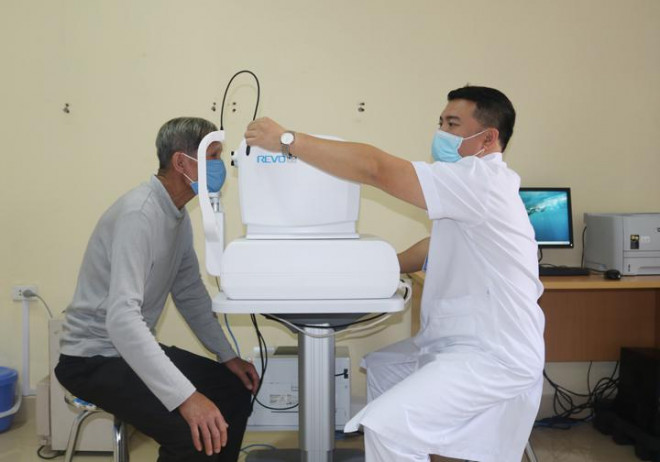How does COVID-19 affect the eyes? -Life Health
Eyes are one of the first organs in the body to be “attacked” by the SARS-CoV-2 virus. Therefore, the early signs of COVID-19 also show up in the eyes, but often the patient does not know or ignore it.
Since the outbreak of the new epidemic, people have found the virus SARS-CoV-2 In the eyes, it causes conjunctivitis, which is also an early manifestation of the disease COVID-19 in people infected with SARS-CoV2.
Virus isolated from eyeball surface specimens such as tears and conjunctiva, is understandable because the surface of the eyeball is the part exposed to the environment with a lot of virus.
In addition, the ocular manifestations are not only the surface of the eyeball but also the posterior parts, which is also recommended for prevention and early detection.
1. Symptoms on the surface of the eyeball
Conjunctivitis with signs of eye redness, conjunctival edema, feeling of sand in the eye, rusty discharge, lacrimation is considered to have the role of SARS-CoV-2.
Because corneal and conjunctival cells have many ACE2 and TMPRSS2 receptors, entry of cloned viruses corona have protein spikes such as early and rampant SAR-CoV-2. Then there are manifestations of local immune response as diverse as red eyes, lacrimation, conjunctival edema.
Conjunctivitis is considered a manifestation of COVID-19 with quite different statistics with prevalence ranging from 1% to 63.6%. Most conjunctivitis is mild or asymptomatic, with only 3% becoming severe.
Conjunctivitis with signs of red eyes, conjunctival edema, feeling of sand in the eyes, rusty discharge, tearing caused by a virus directly or also must be distinguished from superinfectious conjunctivitis, due to an immune disorder , due to the disadvantages of mechanical ventilation and active treatment… still controversial. However, it does not appear to be the virus’s own ‘sin’, as PCR testing (according to a Chinese study) found only 16.7% of the virus on the conjunctival conjunctiva of people with COVID compared with that in nasopharyngeal infections. 91.7%.
In addition to conjunctival manifestations, patients with COVID may develop conjunctivitis or episcleritis as a result of an uncontrolled inflammatory and immune response mechanism.
2. Symptoms of COVID-19 on the uvea
ACE2 receptors are also present in the uvea, which is an anatomical site where viruses can enter. After the early stages of conjunctivitis, the virus can cause uveitis, with various manifestations:
– Decreased eyesight
– Tyndall room fee
– Sticky back
– Vitritis
– Papillomatitis
– Peripillitis retinitis
– Subretinal fluid.
3. Damage to the retina of the eye due to COVID-19
Survey on OCT (retinal tomography) of some COVID patients, it was found that there is increased reflex, indicating damage to retinal ganglion cell layer and inner plexus layer. Fundus examination may reveal cottony exudates, microhemorrhages along the vascular arches suggestive of retinal ischemia, flame hemorrhages, and macular hemorrhages with hard exudates. Despite all of the above lesions, the vision of these patients did not decrease. There is an isolated case report of a suspected VZV-associated retinitis, possibly an opportunistic infection, in a patient with COVD-19 who received immunosuppressants.

OCT scan can detect retinal damage in COVID-19 patients.
4. Damage to the ophthalmic nerve
Ocular nerve damage in COVID patients is mentioned in the literature as ophthalmic paralysis, double vision, cranial nerve palsy, sudden loss of vision, impaired comagnetic reflexes.
Miller Fisher syndrome (MFS), a form of Guilain-Barre syndrome presenting with a triad: ophthalmoplegia, motor ataxia, and bilateral loss of reflexes was observed in one patient. Thereafter, the disease was relieved by injection of immune serum.
Diplopia (seeing 2 images of the same object) and ophthalmoplegia due to cranial nerve palsy have also been reported in COVID patients. On T2 MRI, the hyperintense shows swelling of the oculomotor nerve. In the late stages, thin atrophy of the rectus muscle can be seen. The above disorders will largely disappear when the disease fully recovers. Isolated diplopia may also be caused by myasthenia gravis following infection, with anti-acetycholine receptor antibodies appearing 2 months after COVID-19 infection, well treated with immunoglobulin injection and intravenous pyridostigmine. Sudden bilateral visual loss can also be caused by myelitis – optic nerve but is quickly reversed by treatment with intravenous methylprednisolone and oral dose reduction.
Sudden vision loss is also traced to hypercoagulability, which has a host of systemic consequences. In the eye can cause thrombosis and retinal thrombosis. Occlusion of the ophthalmic artery, central retinal artery, retinal ischemia, and optic nerve are all possible. Even higher is the vascular accident of the central nervous system, the blood clotting disorder can cause infarction of the visual cortex in the occipital lobe, causing sudden blindness on both sides.
The phenomenon of Adie pupils has also been sporadically recorded in COVID-19 patients.
5. With eye sockets
Although the association is unclear, some orbital pathologies are also common in COVID patients. The reason is complicated, but it is probably due to long-term immobilization, systemic aggravating factors, use of immunosuppressive drugs that have caused inflammation of the orbital tissue, which often occurs in young patients.
A series of oropharyngeal and orbital fungal infections have been reported in India, probably due to overuse of antibiotics and steroids, predisposing to diabetes. Once infected with orbital fungus, the possibility of having to dredge the orbital organization is very high, the prognosis for life is also very heavy. Therefore, when a patient with diabetes is infected with COVID-19, it is necessary to closely monitor the orbital complications such as: eyelid edema, eye protrusion, corneal regurgitation, decreased visual acuity and ophthalmic movement.
In short, the COVID-19 pandemic is still complex and new strains may emerge. For ophthalmologists, understanding of the effects of COVID-19 is already available, but further studies will be needed.
at Blogtuan.info – Source: 24h.com.vn – Read the original article here





